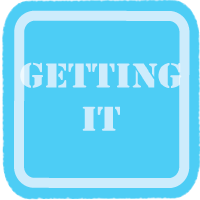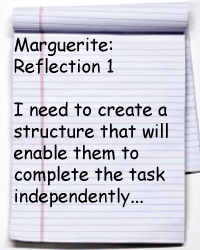 Offering Structure and Support in the Language Classroom
Offering Structure and Support in the Language Classroom
 As we have seen in several of the case studies, many teachers are unaware of how to provide their students with the structure and support they need in order to be successful in their learning. Structure and support go hand in hand and are therefore referred to simultaneously. These terms refer to what the teacher must consider for the learners to successfully complete the task. Our society too quickly uses the word `cheating´ when a student relies on support, not understanding that learning supports are necessary and helpful during the learning process. It is only later in the learning process when students must prove what they have learned, such as during a test, that they should not use supports and to do so would actually be cheating. Instead, we have as a society reinforced the notion that seeking supports, reminders, cues, is not acceptable and call it cheating. In this section we will discuss how structure and support can be built into a language classroom and how B-SLIM can facilitate their regular use. |
|
What are structure and support, and how are they related?
Structure and support go hand in hand with one another and therefore we discuss them as paired concepts. When a teacher is preparing the classroom activities he or she must also consider what the learners need in order to successfully complete the task. In order to succeed in this the teacher ought to bear in mind the notions of Multiple Intelligences and Bloom's Taxonomy and how these can be scaffolded together. An activity needs to be broken down into its constituent parts and the teacher must consider each part of an exercise in order to build in the proper supports.
An example should make this clearer. In the sense of a one minute pair activity, a teacher who has done this activity many times might view the process as giving each student a piece of paper and requiring that the students talk. The reality however is that it is a much more complex process than this. The teacher must put the activity in a certain sequence. This sequence is the structure of the activity. The material provided to the students is the support which is required for them to be able to succeed at the activity.
back to top
How can I provide structure and support for my students?
One reason developing oral language in a second language context is a challenge is because teachers may not be aware of the necessary structure and support. Teachers at all stages of their career need to be aware of the structures and supports that are necessary for students to succeed. Sometimes this awareness can be the biggest challenge, especially for beginner teachers, who may perceive that there is little need for structure or support for simple or basic activities.
Let’s look at an example:
A teacher decides that the class Is going to put on a party. The activity is planned so that the class needs to announce the party, make initiations, make decorations, plan food and then throw the party. This may seem like the activity has been broken into steps but in fact, each of these steps consists of even more smaller steps. Each task needs to be structured in a way where students know what is to be done first, second and third and they need the necessary support in order to succeed. A great strategy to help the teacher in this example to is to create a task analysis of all materials and every step necessary to complete the task. This will provide the teacher with better insight into the type of structure and support students will need to be successful.
How does support fit into the B-SLIM model?
The need for support is greater in the earlier stages of B-SLIM and phases out as we proceed forward. When the teacher is presenting something new in the Giving It stage, they have to provide extra supports that will help the student understand what is being taught. As we know, the more gestures, facial expressions, actions, mnemonics, and visual cues that you give, the more support you are giving to the student’s memory.
In the Getting It stage, these supports need to be visible. The most important support is the written word, as long as the students can read and can pronounce accurately, then written supports can be very beneficial during the Getting It stage. The challenge is to remove supports as you move through the activities so that you know that the students have internalized those words or concepts. This relates largely to the structure provided for students and how a sequence is scaffolded.
During the Using It stage students need to be given more structure than support meaning that activities and tasks need to be planned and delivered in a way that does not overload students. This relates back to the party example in the previous section where students needed to be told the steps to compete a task so that they could concentrate on actually using and applying their language to the context.
back to top
 |
Test your knowledge of Offering Structure & Support with this quiz. |









 back to...
back to...